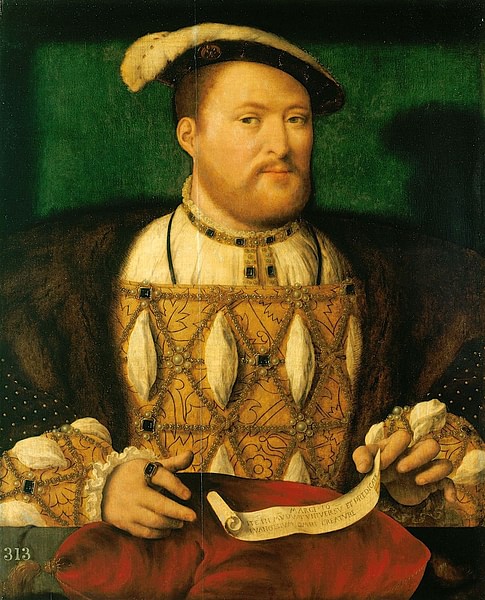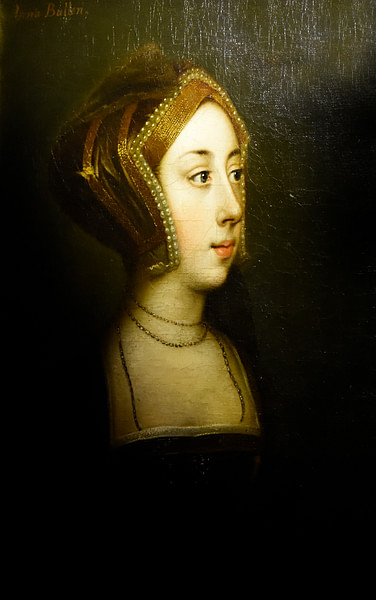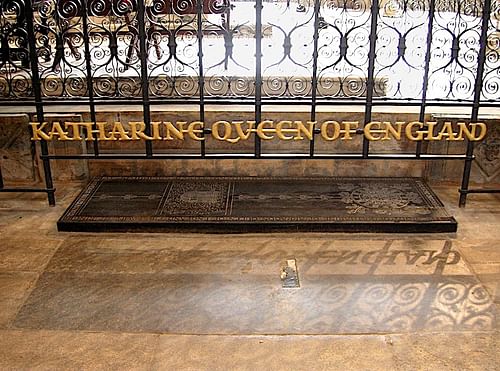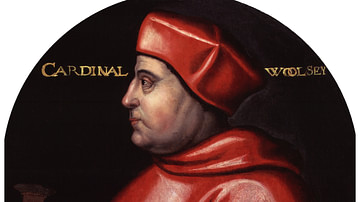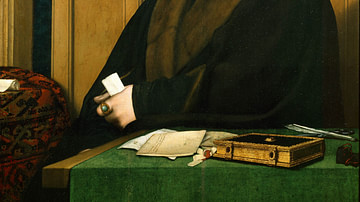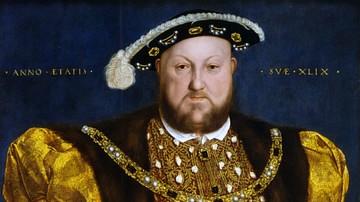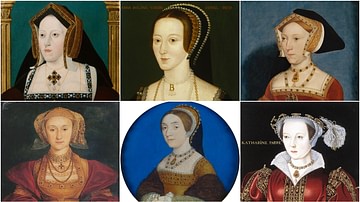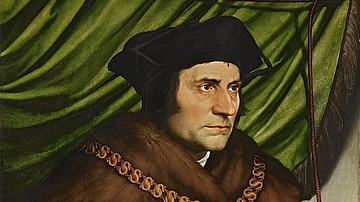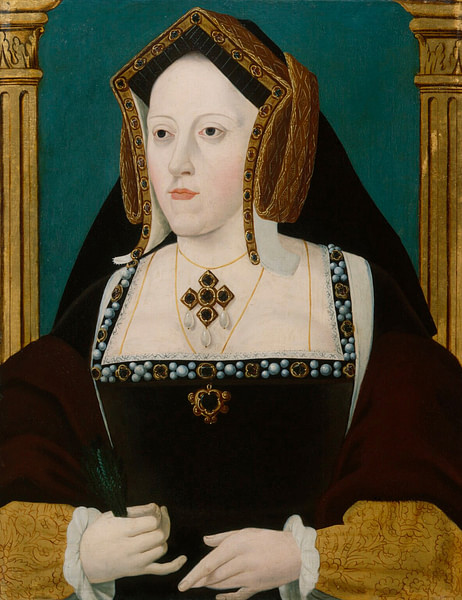
Catherine of Aragon (1485-1536 CE) was a Spanish princess who famously became the Queen of England and the first wife of Henry VIII of England (r. 1509-1547 CE). When the marriage did not produce a male heir, Henry VIII became desperate to divorce Catherine and find another wife. Catherine refused to cooperate with the king's wishes and the Pope refused to annul the marriage, leading Henry to take the drastic step of splitting the Church in England away from Rome. The marriage, perhaps the most fateful in English history, was finally annulled in 1533 CE and Catherine was banished to a life of retirement until her death from illness in 1536 CE. Catherine's legacy continued, though, with the crowning of her daughter with Henry, Mary I of England in 1553 CE.
A Spanish Princess
Catherine of Aragon was born on 15 December 1485 CE, the youngest daughter of King Ferdinand II of Aragon (r. 1479-1516 CE) and Queen Isabella of Castile (l. 1451-1504 CE). Catherine's first brush with the English monarchy was not with Henry VIII but his elder brother Prince Arthur (b. 19 September 1486 CE). Henry VII of England (r. 1485-1509 CE) had arranged for his eldest son Arthur, Prince of Wales, to marry Catherine as early as 1488 CE when Arthur was just 18 months old and Catherine was three. The official agreement between the two royal houses was set out in the Treaty of Medina del Campo of 27 March 1489 CE. Henry VII was promised a large dowry from Ferdinand II, and the two countries formed a handy alliance against their common enemy, France.
Arthur and Catherine, now teenagers, married on 14 November 1501 CE in Saint Paul's Cathedral, London. The young couple lived in Ludlow Castle, Wales, but unfortunately, the marriage did not last long as Arthur died of consumption the next year, aged just 15 (2 April 1502 CE). Henry VII was not about to lose the political advantages of lasting family ties with Spain and so, in September 1502 CE, he arranged for his second eldest son, Henry (b. 1491 CE), to marry Catherine. Special permission was granted from the Pope and, when the last instalment of the dowry finally arrived, the young couple were married on 11 June 1509 CE at the Church of the Franciscans in Greenwich. Henry VII had died in April of that year and so Prince Henry became Henry VIII of England on 24 June 1509 CE and, just as his father had wished, Catherine his queen.
Henry, then 18, was quite a catch in his youth, casting a tall athletic figure and possessing a charming if forceful character. Catherine, then 24, had her charms too and was regarded as a beauty. She was also very well educated and, although her English was shaky, she was fluent in French and Latin, besides her native Spanish. The royal wedding was followed by a splendid banquet in Westminster Hall and a round of medieval tournaments that lasted a week. Henry wrote in a letter to his father-in-law, "My wife and I be in good and perfect love as any two creatures can be" (quoted in Ralph-Lewis, 88).
Producing an Heir
As with any king, Henry's main objective was to produce a male heir. Catherine obliged with six children but none of them survived infancy except one, a girl, Mary, born on 18 February 1516 CE. Catherine gave birth to a stillborn girl in 1510 CE, a son was born in 1511 CE but died two months later, a second son arrived in 1513 CE but died a few hours after birth, and a third son was stillborn in 1514 CE. After Mary, a daughter was stillborn in 1518 CE. The queen's personal badge, a pomegranate, traditional symbol of fertility, was proving to be an entirely unsuitable choice.
When Henry had an illegitimate son, Henry Fitzroy, Duke of Richmond (b. 1519 CE), with a mistress, one Elizabeth Blount, the king began to blame his queen for not producing a healthy and legitimate male heir. It did not help that six births had taken their physical toll on Catherine. The Queen had aged, lost her figure, and her hair had gone prematurely grey. Catherine also turned to religion more and more, spending her time in prayer and even sometimes wearing a hair shirt like an ascetic. The queen's piety, stubbornness, and courage would combine to exasperate her husband, but now over 40, it seemed her chances of bearing a healthy son were slim. Henry began to look for a second, younger and more exciting wife, even if relieving himself of his first one, his so-called 'great matter', would prove far more difficult than he could ever have imagined.
Divorce: The Intractable Problem
From around 1526 CE, Henry VIII's eye was caught by one Anne Boleyn, younger sister of one of his former conquests. Anne, clever enough to realise she was about to become a pawn in a game of thrones, refused to sleep with the king until they were married. To this end, Henry wrote a letter to Pope Clement VII (r. 1523-1534 CE) in 1527 CE suggesting that the lack of a male heir was God's punishment for Henry marrying the wife of his late brother, a point supported by the Old Testament. The passage, often referred to as the 'Prohibition of Leviticus', reads:
If a man shall take his brother's wife, it is an impurity; he hath uncovered his brother's nakedness; they shall be childless.
(Leviticus ch. 20 v. 21).
Consequently, the king wished for the Pope to annul the marriage because it should never have been allowed in the first place (divorce not being allowed in the Catholic Church). In England, Henry charged one man to achieve his goal: Cardinal Archbishop of York, Thomas Wolsey (l. c. 1473 - 1530 CE), the king's sole minister and holder of the very highest office in the land. Wolsey would eventually displease the king for his lack of success in resolving the 'great matter' but there was little he could do against a Pope who did not need either political or financial support from England. On the contrary, the power was all in the other direction since if a Pope excommunicated a monarch, in theory, any rival monarch could challenge his right to rule, perhaps leading to an invasion of England by a foreign power.
Henry also faced the problem that Catherine was much more popular amongst his subjects than Anne Boleyn. The king had to be wary of giving a pretext for any popular revolt in his kingdom. Catherine had powerful supporters at court, too, who both sympathised with her cause and were reluctant to see any divisions created in the Church. These are sometimes called the Aragonese faction by historians and they included the Marquis of Exeter, Lord Darcy, and Lord Hussey. Another problem was that, in England, disputes of marriage were heard in Church courts and if Henry called such a court it would be led by the archbishop of Canterbury, William Warham, who was dead against a royal divorce.
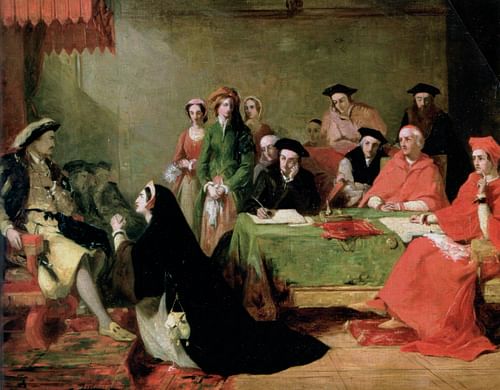
Perhaps inevitably, given the seemingly intractable problem he had to grasp, Wolsey was eventually accused of treason but he died on his way to trial in 1530 CE. Unfortunately for Wolsey and Henry, Pope Clement VII was keen to keep good favour with the most powerful ruler in Europe at the time, Emperor of the Holy Roman Empire, Charles V of Spain (r. 1519-1556 CE), who was, significantly, the nephew of Catherine. Further, it was unlikely that Catherine and Arthur, being so young at the time, had ever slept together and so the 'Prohibition of Leviticus' did not in this case apply. Finally, another passage of the Bible, this time in Deuteronomy, seemed to contradict Leviticus and read:
When brethren dwell together and one of them dieth without children, the wife of the deceased shall not marry to another: but his brother shall take her, and raise up seed for his brother.
(Deuteronomy ch. 25 v. 5)
To find some sort of solution, the Pope at least sent Cardinal Lorenzo Campeggio to England to investigate the matter and preside over a special court in June 1529 CE. Here both Catherine, determined to stay queen, and Henry, determined to get himself a new queen, presented their respective cases, although Catherine formally declared this court had no right to hear her, only the Pope did. Despite Campeggio's efforts, nothing was resolved.
When Thomas Cromwell (l. c. 1485-1540 CE) took over the 'great matter' from Wolsey, Henry's will was pushed to its logical conclusion: England would run its own Church free from the obligations of Rome. Henry was sticking to his interpretation of the Bible, a higher authority than even the decision of a Pope.
Henry's next tactic was to permanently separate Catherine from her daughter Mary in 1531 CE and shift her about the country to various dilapidated residences. Mother and daughter would never see each other again. Meanwhile, Henry and Anne Boleyn lived together (but still did not sleep together). Sometime in December 1532 CE, Anne, perhaps seeing a baby as the best and only way to rid herself of her rival Catherine, did sleep with the king and she became pregnant. Now, though, the whole issue had blown up into a major religious disagreement with far greater consequences than who would be Henry's heir.
Marriage Annulment
Thomas Cranmer, a much more compliant replacement to Warham as the Archbishop of Canterbury and a man keen to split the English Church from Rome, formally annulled Henry's first marriage on 23 May 1533 CE. With the passing of the Act in Restraint of Appeals by Parliament (drafted by Cromwell), Catherine had no recourse to any appeal. The decision was final. The annulment and Parliament's passing of the Act of Succession (30 April 1534 CE) meant that Catherine's daughter Mary was declared illegitimate. Catherine was forbidden from using the title 'Queen of England' and had to instead use 'Princess Dowager'.
Anne Boleyn, often known as 'Anne of a thousand days', had married Henry in secret on 25 January 1533 CE but she enjoyed only a brief reign as queen of the king's heart. Anne Boleyn was crowned queen on 1 June 1533 CE and Henry had a second daughter with her, Elizabeth, born on 7 September 1533 CE but the king would marry again, four times more in fact. His third wife, Jane Seymour would give the king a son, Edward, born on 12 October 1537 CE.
The Reformation
Henry was eventually excommunicated by the Pope for his actions in annulling his first marriage but the English king was far from finished with reforming the whole structure of the Church in his kingdom. Now, in order to replace the Pope as head of the Catholic Church in England, Henry made himself head of the Church of England. This was achieved by the Act of Supremacy of 28 November 1534 CE and meant that Henry, and all subsequent English monarchs, only had one higher authority: God himself. The next scene in this momentous drama came in 1536 CE when Henry passed through Parliament a bill to dissolve all monasteries in his kingdom. A good many subjects were keen to see reform in the Church and so continue the Protestant Reformation movement that was sweeping across Europe. Many regarded the Church as too rich and too full of priests abusing their position.
Certainly not everyone, however, was in agreement with Henry's break from the Pope. Consequently, there were both executions and uprisings. Chief obstacle at court was Sir Thomas More (1478-1535 CE), Henry's former chancellor who disagreed with the divorce with Catherine and Henry's presumption to put himself above the Pope. More was executed for his beliefs in July 1535 CE. A major uprising was the so-called Pilgrimage of Grace in 1536 CE in the north of England. The king would brook no opposition, though, and 178 of the protestors were executed in June 1537 CE. Another move towards independence was the king's approval for a translation of the Bible in English in 1539 CE. Henry was not dead set on reforming the doctrine of the Church, he remained committed to traditional Catholic practices such as mass, confession and clerical celibacy, but the road to religious reform and independence was now set out for his successors to pursue.
Later Life
Catherine, meanwhile, was confined to her residence at Buckden in Cambridgeshire from 1533 CE and Kimbolton after 1534 CE. In 1536 CE and with failing health, the former queen wrote one last letter to King Henry, whom she had not seen for five years:
My most dear lord, king and husband: the hour of my death drawing on, the tender love I owe you forceth me…to commend myself to you and to put you in remembrance…of the health and safeguard of your soul, which you ought to prefer to all worldly matters…for which you have cast me into many calamities and yourself into many troubles. For my part, I pardon you everything and I wish devoutly to pray God that He will pardon you also. For the rest, I commend unto you our daughter Mary, beseeching you to be a good father to her…Lastly, I make this vow, that mine eyes desire you above all things. Farewell. Catherine, Queen of England'
(Ralph Lewis, 96)
The use of her original title to close the letter was one final defiance towards her former husband. Catherine, wasting away from not eating and wracked with cancer, died aged 50 on 9 January 1536 CE. The former queen was buried in Peterborough Cathedral. Catherine's daughter Mary did become queen in her own right, crowned Mary I of England in 1553 CE. Mary would reign until 1558 CE when she was succeeded by her half-sister Elizabeth I of England (r. 1558-1603 CE).
